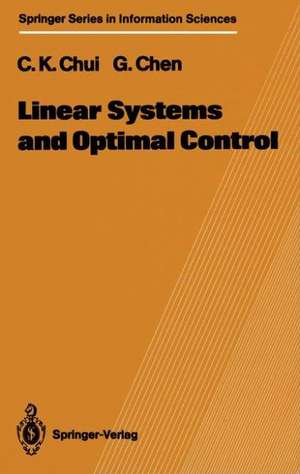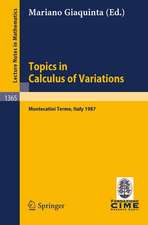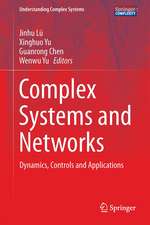Linear Systems and Optimal Control: Springer Series in Information Sciences, cartea 18
Autor Charles K. Chui, Guanrong Chenen Limba Engleză Paperback – 15 apr 2014
Din seria Springer Series in Information Sciences
- 20%
 Preț: 337.66 lei
Preț: 337.66 lei - 18%
 Preț: 955.08 lei
Preț: 955.08 lei - 15%
 Preț: 646.62 lei
Preț: 646.62 lei - 20%
 Preț: 337.52 lei
Preț: 337.52 lei -
 Preț: 385.62 lei
Preț: 385.62 lei -
 Preț: 381.98 lei
Preț: 381.98 lei -
 Preț: 391.61 lei
Preț: 391.61 lei - 20%
 Preț: 324.64 lei
Preț: 324.64 lei - 18%
 Preț: 777.69 lei
Preț: 777.69 lei -
 Preț: 387.96 lei
Preț: 387.96 lei -
 Preț: 396.62 lei
Preț: 396.62 lei - 20%
 Preț: 330.75 lei
Preț: 330.75 lei -
 Preț: 382.57 lei
Preț: 382.57 lei - 15%
 Preț: 642.18 lei
Preț: 642.18 lei - 15%
 Preț: 640.06 lei
Preț: 640.06 lei -
 Preț: 387.58 lei
Preț: 387.58 lei - 20%
 Preț: 333.40 lei
Preț: 333.40 lei -
 Preț: 386.99 lei
Preț: 386.99 lei - 20%
 Preț: 653.71 lei
Preț: 653.71 lei - 15%
 Preț: 661.02 lei
Preț: 661.02 lei - 18%
 Preț: 1391.21 lei
Preț: 1391.21 lei - 15%
 Preț: 638.43 lei
Preț: 638.43 lei - 15%
 Preț: 642.68 lei
Preț: 642.68 lei -
 Preț: 386.00 lei
Preț: 386.00 lei - 20%
 Preț: 649.60 lei
Preț: 649.60 lei - 18%
 Preț: 950.21 lei
Preț: 950.21 lei -
 Preț: 393.35 lei
Preț: 393.35 lei - 20%
 Preț: 652.41 lei
Preț: 652.41 lei - 20%
 Preț: 645.65 lei
Preț: 645.65 lei -
 Preț: 390.25 lei
Preț: 390.25 lei -
 Preț: 387.96 lei
Preț: 387.96 lei - 15%
 Preț: 580.97 lei
Preț: 580.97 lei
Preț: 380.84 lei
Nou
Puncte Express: 571
Preț estimativ în valută:
72.88€ • 77.93$ • 60.76£
72.88€ • 77.93$ • 60.76£
Carte tipărită la comandă
Livrare economică 18 aprilie-02 mai
Preluare comenzi: 021 569.72.76
Specificații
ISBN-13: 9783642647871
ISBN-10: 3642647871
Pagini: 168
Ilustrații: VIII, 155 p. 1 illus.
Dimensiuni: 155 x 235 x 17 mm
Greutate: 0.25 kg
Ediția:Softcover reprint of the original 1st ed. 1989
Editura: Springer Berlin, Heidelberg
Colecția Springer
Seria Springer Series in Information Sciences
Locul publicării:Berlin, Heidelberg, Germany
ISBN-10: 3642647871
Pagini: 168
Ilustrații: VIII, 155 p. 1 illus.
Dimensiuni: 155 x 235 x 17 mm
Greutate: 0.25 kg
Ediția:Softcover reprint of the original 1st ed. 1989
Editura: Springer Berlin, Heidelberg
Colecția Springer
Seria Springer Series in Information Sciences
Locul publicării:Berlin, Heidelberg, Germany
Public țintă
ResearchCuprins
1. State-Space Descriptions.- 1.1 Introduction.- 1.2 An Example of Input-Output Relations.- 1.3 An Example of State-Space Descriptions.- 1.4 State-Space Models.- Exercises.- 2. State Transition Equations and Matrices.- 2.1 Continuous-Time Linear Systems.- 2.2 Picard’s Iteration.- 2.3 Discrete-Time Linear Systems.- 2.4 Discretization.- Exercises.- 3. Controllability.- 3.1 Control and Observation Equations.- 3.2 Controllability of Continuous-Time Linear Systems.- 3.3 Complete Controllability of Continuous-Time Linear Systems.- 3.4 Controllability and Complete Controllability of Discrete-Time Linear Systems.- Exercises.- 4. Observability and Dual Systems.- 4.1 Observability of Continuous-Time Linear Systems.- 4.2 Observability of Discrete-Time Linear Systems.- 4.3 Duality of Linear Systems.- 4.4 Dual Time-Varying Discrete-Time Linear Systems.- Exercises.- 5. Time-Invariant Linear Systems.- 5.1 Preliminary Remarks.- 5.2 The Kalman Canonical Decomposition.- 5.3 Transfer Functions.- 5.4 Pole-Zero Cancellation of Transfer Functions.- Exercises.- 6. Stability.- 6.1 Free Systems and Equilibrium Points.- 6.2 State-Stability of Continuous-Time Linear Systems.- 6.3 State-Stability of Discrete-Time Linear Systems.- 6.4 Input-Output Stability of Continuous-Time Linear Systems.- 6.5 Input-Output Stability of Discrete-Time Linear Systems.- Exercises.- 7. Optimal Control Problems and Variational Methods.- 7.1 The Lagrange, Bolza, and Mayer Problems.- 7.2 A Variational Method for Continuous-Time Systems.- 7.3 Two Examples.- 7.4 A Variational Method for Discrete-Time Systems.- Exercises.- 8. Dynamic Programming.- 8.1 The Optimality Principle.- 8.2 Continuous-Time Dynamic Programming.- 8.3 Discrete-Time Dynamic Programming.- 8.4 The Minimum Principle of Pontryagin.- Exercises.- 9.Minimum-Time Optimal Control Problems.- 9.1 Existence of the Optimal Control Function.- 9.2 The Bang-Bang Principle.- 9.3 The Minimum Principle of Pontryagin for Minimum-Time Optimal Control Problems.- 9.4 Normal Systems.- Exercises.- 10. Notes and References.- 10.1 Reachability and Constructibility.- 10.2 Differential Controllability.- 10.3 State Reconstruction and Observers.- 10.4 The Kalman Canonical Decomposition.- 10.5 Minimal Realization.- 10.6 Stability of Nonlinear Systems.- 10.7 Stabilization.- 10.8 Matrix Riccati Equations.- 10.9 Pontryagin’s Maximum Principle.- 10.10 Optimal Control of Distributed Parameter Systems.- 10.11 Stochastic Optimal Control.- References.- Answers and Hints to Exercises.- Notation.





















